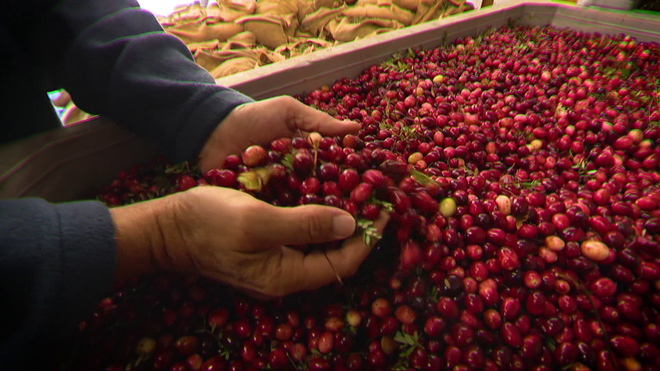Mass. cranberry growers fighting to stay competitive in changing landscape

In bogs all over southeastern Massachusetts and Cape Cod
Click here for updates on this story
MIDDLEBOROUGH, Massachusetts (WCVB) — In bogs all over southeastern Massachusetts and Cape Cod, a native fruit has thrived for generations: cranberries.
But to local cranberry farmers like Cass Gilmore, a third-generation owner of Benson’s Pond in South Middleboro, the future is murky.
But at harvest time, there’s little time for questions. Or, as Gilmore says, “Every season’s busy, but this is the busiest.”
On a recent visit, the bogs had already been flooded with water, and harvesting machines had done their work, too, helping ease the ripe, red berries from the vines they grow on, bringing them bobbing to the surface to be corralled and collected.
It’s the same autumn routine, more or less, for the estimated 300 cranberry growers in Massachusetts still working in an industry that dates back to the 1800s here.
But growers have been tested in recent years with everything from climate change to farms getting out of the business.
“What would you say the biggest challenge is that you’re facing as a grower?” 5 Investigates’ Mike Beaudet asked Gilmore.
“The price squeeze is tough,” he replied. “It’s commodity fruit, so we’re getting paid 35-40 cents a pound. So how do you make that work with oil at whatever, $120?”
And it’s not just the bottom line.
Cranberries are still the number one food crop in Massachusetts, but the state lost its standing as the top producer in North America when Wisconsin took over in the 1990s. And Quebec is now the number two producer.
“Last year was a pretty tough year production-wise for most growers,” said Brian Wick, executive director of Massachusetts Cranberries, an advocacy group for growers. “We’re in the highest cost growing region, so our costs are higher. The price that they get for their fruit doesn’t keep up with that. So they have to find ways to lower their costs.
The challenges are forcing the state’s cranberry industry to innovate. Growers are revamping their bogs with new vines that allow them to produce bigger cranberries and more of them in the same bogs. More than half of the state’s bogs have been transferred over to higher-yielding plants, according to Massachusetts Cranberries, which is counting on the state for additional support to do more.
But the process is expensive. Longtime cranberry farmer Dick Ward has converted 4.4 of his 11 acres to the higher-yielding varietal. He’s also added solar panels to create extra income.
His son Steve, also a cranberry farmer, said conversion is “an expensive proposition to renovate. So out of my a hundred acres, about 12 acres, I can maybe do three acres every other year.”
It’s hardly a new problem. In 2016, the Massachusetts Cranberry Revitalization Task Force released a report warning the industry was in “dire straits.”
“It’s certainly a challenge and there is always the ‘what if,'” said Ashley Randle, commissioner of the Massachusetts Department of Agricultural Resources.
To help, the department’s Cranberry Bog Renovation Grant Program has provided growers with a million dollars each year since 2020 to help renovate their bogs.
“What do you say about the viability of this industry here in Massachusetts?” Beaudet asked.
“I would say that we’re moving in a positive direction and a lot of that goes to the bog renovations. That’s how we’re continuing to compete,” Randle replied.
Randle agrees more needs to be done for the industry, including focusing on workforce development.
Back at Benson’s Pond, Cass Gilmore is diversifying. The farm now offers bog tours and rents out their barn for weddings.
“Do you hope that this farm stays in your family for generations to come?” Beaudet asked.
“Oh yeah, of course. I’d hate to be the last one,” Gilmore replied.
Please note: This content carries a strict local market embargo. If you share the same market as the contributor of this article, you may not use it on any platform.